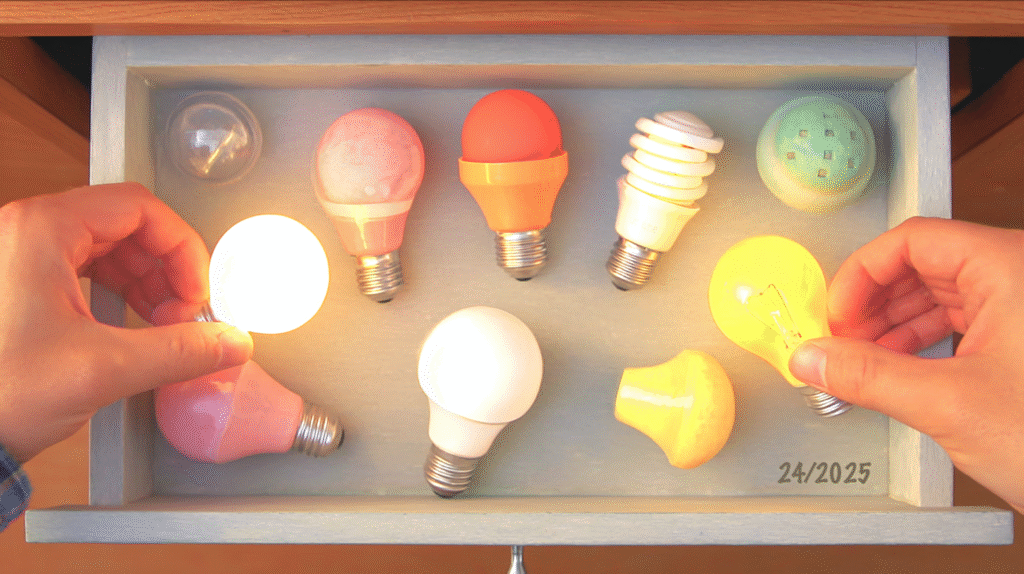
Image © Jose 2025
I never thought that lighting could be a source of tension and frustration between me and others, and here we are. And just to think that almost 10 years ago, when I joined the lighting domain, all I knew about it was if it was on or off. I grew up in the incandescent age, lived with fluorescent, dealt with a lot of halogen (so many dichroic), and then witnessed the dawn of LED, so I have a pretty good user experience of the technology stages, but somehow it seems the other evolutions were less disruptive, or maybe I didn’t feel them as much because I was not in the lighting domain.
There was a time when all I remember having around were incandescent bulbs. The only choice I believe we had was the wattage, we sort of knew that 40w was a dim light, generally used 60w, and there were a few places that required 100w bulbs. The plastic lamp holders would heat up and turn yellowish brown, shades would burn if they were too close. They were made of glass – I remember breaking a few- and the routine of changing light bulbs was a given. I remember vividly shaking them to see if the filament was bouncing around, yep, this one is done.
We started seeing daylight incandescent bulbs, which at the time was pretty different from other incandescent lighting. I am not sure we equated the lighting to sunlight, but it stuck and later informed the LED revolution. At the same time, we had fluorescent, mainly tubes, that required starters. Those were also glass, and when they broke it was messy. They all seemed white, very white, fluorescent white, but worked well in places where you needed to flood the place with lighting.
The world had a lot of track lighting when I was growing up, and with it the small dichroic lamps with their reflectors. These were different wattages, but no color temperature or intensity. These lights were the ones I remember using dimmers with, and in so many basements where we met to listen to music, atmospheric places filled with cigarette smoke, these were the lights used everywhere.
Then we started seeing LED lamps. They were shaped like the incandescent bulbs but had plastic parts separating the bulb, no more glass. In the beginning, I remember the battlefront was in understanding watts in incandescent versus watts in LED. Then they started becoming more and more powerful, and the light was white, very white sometimes.
Apart from lighting in concerts and theater, I don’t remember seeing color lighting at home until 15 years ago. Probably the first serious look at it was via Philips Hue. In the last 5 to 7 years, I noticed that LED lighting started becoming weaponized and politicized. While LEDs were and are getting better – not just more efficient but overall better – a counter trend started to shape up and we started seeing people discussing the pros and cons of LED versus other lighting, especially incandescent. The whole discussion about blue light, flicker, mixed reviews on health and well-being, glare… but above all, a very heated conversation about color temperature.
While the spectrum allows a typical use of 2,800K to 5,000K, these extremes became areas of dispute, between traditionalists and futurists, Europeans and Americans, zealots and believers, democrats and republicans. While no one seems to dispute the energy savings that are at the basis of LED adoption, it seems that pretty much everything else is up for grabs.
In this house renovation, I sort of assumed that I would be doing the lighting along with the electrician, but I was naïve in thinking that this would be a foregone conclusion. The use of LED lamps – connected or not – has become an area of contention, one I was not really expecting. The lady of the house likes the lighting that incandescent bulbs produce. It doesn’t matter if it is nostalgia, habit, perception, she just does. And the color temperature of choice is 2,800K (yellow, to me – warm, to her). I have been able to push to 3,000K in the kitchen, after she tried other solutions for a while. For me, I prefer in many cases 3,000/4,000K, dimmable but slightly more white.
For a while we were progressing toward LED adoption at a fast pace. Her complaint was that she could not buy incandescent bulbs. Now she can, and she has done so. And so we find ourselves testing lighting solutions, discussing, many times agreeing to disagree, on something that may be at the core of many other issues about LED adoption, and certainly at the core of many other issues where simple things are being weaponized and politicized. I feel this ‘dance’ will continue. I find myself changing bulbs without her noticing, and she does the same. We each have our stash, and we are taking notes and counting small victories.
Who would say that lighting could do this?
History says that perhaps lighting always did this. Looking back – from gaslight protests in 19th-century Paris, to early electrification in Berlin and New York, to the rise of neon, halogen, and now LED – lighting has never been just about light. It’s about visibility, power, trust, and personal meaning. It shows what we value. What we argue over. What we choose to see, and what we don’t.
Comments
Powered by WP LinkPress